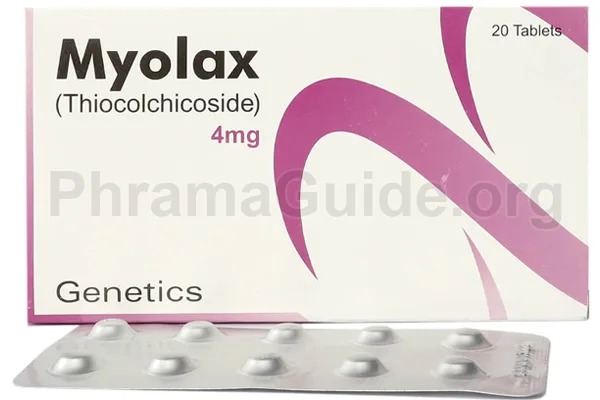Myolax tablet is a muscle relaxant medication that is primarily used for the treatment of musculoskeletal conditions associated with muscle spasms and pain. Following are some common uses of Myolax Tablet:
- Musculoskeletal Conditions: Myolax tablet is used to relieve muscle spasms and associated pain in various musculoskeletal conditions, including acute back pain, cervical and lumbar syndromes, torticollis (wry neck), muscle strains, and sprains.
- Fibromyalgia: Myolax tablets may be used as part of a comprehensive treatment plan for fibromyalgia, a chronic condition characterized by widespread musculoskeletal pain and tenderness.
- Sports Injuries: Myolax tablet can be used to alleviate muscle spasms and discomfort caused by sports injuries, such as strains, sprains, and muscle cramps.
- Postoperative Muscle Stiffness: Myolax tablet is sometimes used to reduce muscle stiffness and spasticity following surgical procedures, particularly those involving the musculoskeletal system.
- Neurological Conditions: In some cases, Myolax tablets may be used to manage muscle spasms and associated pain in certain neurological conditions, such as multiple sclerosis and spinal cord injuries.
Off-label Uses of Myolax Tablet
- Myolax tablets can also be used for the treatment of neuralgia, parkinsonism, and sciatica pain. It can be used for long-term treatment or on an as-needed basis for acute flare-ups of muscle pain.

What is Myolax?
Myolax is one of the leading brands of Thiocolchicoside, manufactured and marketed by Genetics Pharmaceuticals, Pakistan.
Myolax Alternatives : Other Similar Brands
Following are some alternative brands of Myolax and their manufacturers.
- Muscoril : Searl Pakistan (Pvt) Ltd.
- Thiolax : S.J & G Fazul Ellahie (Pvt) Ltd, Pakistan.
- Thiocol : Ray Pharma (Pvt) Ltd, Pakistan.
- Muscor : Genome Pharmaceuticals (Pvt) Ltd, Pakistan.
- Muscorex : Genome Pharmaceuticals (Pvt) Ltd, Pakistan.
- Relspasm : Wilshire Laboratories, Pakistan.
- Muscolax : Panacea Pharmaceuticals.
- Ezoside : Akhai Pharmaceuticals, Pakistan.
- Caelyx : Rotex Medica Pakistan (Pvt) Ltd.
- Myosoft : Pharmix Laboratories (Pvt) Ltd.
Myolax : Available Formulations and Strengths
Presently, Myolax is available in Tablet and Injection Forms
Myolax Tablet : 4mg strength
Myolax Injection : 4mg/2ml strength
Who Should Not Use Myolax?
Myolax has some contraindications and precautions that should be considered before using the medication.
- Hypersensitivity: Individuals who have known hypersensitivity or allergic reactions to Myolax or any of its components should avoid its use.
- Severe renal impairment: Myolax is primarily eliminated through the kidneys, so caution is advised in individuals with severe renal impairment. Dose adjustments may be necessary in such cases.
- Severe hepatic impairment: Myolax is metabolized in the liver, and individuals with severe hepatic impairment should use caution and may require dose adjustments.
- Pregnancy and breast-feeding: There is limited information available regarding the safety of Myolax during pregnancy and breastfeeding. It is generally recommended to avoid its use during these periods unless the potential benefits outweigh the potential risks.
- Children and adolescents: The safety and efficacy of Myolax have not been well-established in children and adolescents. It is typically not recommended for use in this age group.
- Myasthenia gravis: Myolax may worsen muscle weakness in individuals with myasthenia gravis, a neuromuscular disorder characterized by muscle weakness and fatigue.
What is the Recommended Daily Dosage of Myolax?
Tablet Dose : 1 tablet Myolax 2 times a day (8mg per day) if needed the dose can be increased up to 2 tablets of Myolax 2 times a day (16mg per day).
Injection Dose : 1 Myolax 4mg Injection administrated as intramuscular 2 times a day. Injection doses and intervals can be adjusted as recommended by a healthcare professional.
Myolax is not recommended for the age group of 16 years or younger.
How Myolax Works?
Myolax has anti-inflammatory and analgesic properties, it works to block the pain signals between muscle and brain by interacting with GABA type A receptors, and strychnine-sensitive glycine receptors.

Leave A Comment